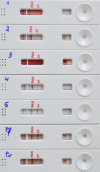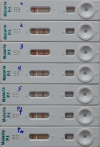Buffer substitution in malaria rapid diagnostic tests causes false-positive results
- PMID: 20650003
- PMCID: PMC3224932
- DOI: 10.1186/1475-2875-9-215
Buffer substitution in malaria rapid diagnostic tests causes false-positive results
Abstract
Background: Malaria rapid diagnostic tests (RDTs) are kits that generally include 20 to 25 test strips or cassettes, but only a single buffer vial. In field settings, laboratory staff occasionally uses saline, distilled water (liquids for parenteral drugs dilution) or tap water as substitutes for the RDT kit's buffer to compensate for the loss of a diluent bottle. The present study assessed the effect of buffer substitution on the RDT results.
Methods: Twenty-seven RDT brands were run with EDTA-blood samples of five malaria-free subjects, who were negative for rheumatoid factor and antinuclear antibodies. Saline, distilled water and tap water were used as substitute liquids. RDTs were also run with distilled water, without adding blood. Results were compared to those obtained with the RDT kit's buffer and Plasmodium positive samples.
Results: Only eight cassettes (in four RDT brands) showed no control line and were considered invalid. Visible test lines occurred for at least one malaria-free sample and one of the substitutes in 20/27 (74%) RDT brands (saline: n = 16; distilled water: n = 17; and tap water: n = 20), and in 15 RDTs which were run with distilled water only. They occurred for all Plasmodium antigens and RDT formats (two-, three- and four-band RDTs). Clearance of the background of the strip was excellent except for saline. The aspects (colour, intensity and crispness) of the control and the false-positive test lines were similar to those obtained with the RDT kits' buffer and Plasmodium positive samples.
Conclusion: Replacement of the RDT kit's dedicated buffer by saline, distilled water and tap water can cause false-positive test results.
Figures


References
-
- Wiese L, Bruun B, Baek L, Friis-Moller A, Gahrn-Hansen B, Hansen J, Heltberg O, Hojbjerg T, Hornstrup MK, Kvinesdal B, Gomme G, Kurtzhals JA. Bedside diagnosis of imported malaria using the Binax Now malaria antigen detection test. Scand J Infect Dis. 2006;38:1063–1068. doi: 10.1080/00365540600818011. - DOI - PubMed
MeSH terms
Substances
LinkOut - more resources
Full Text Sources
Medical
Miscellaneous

